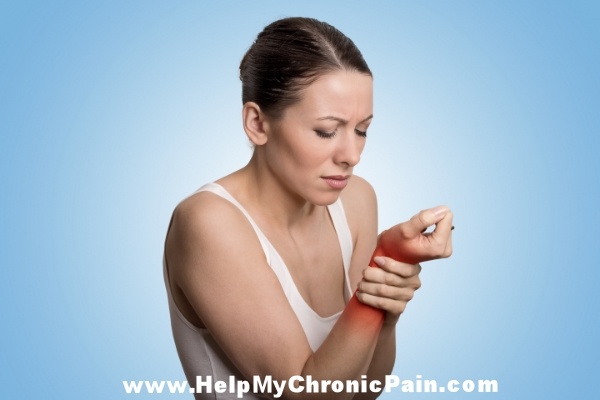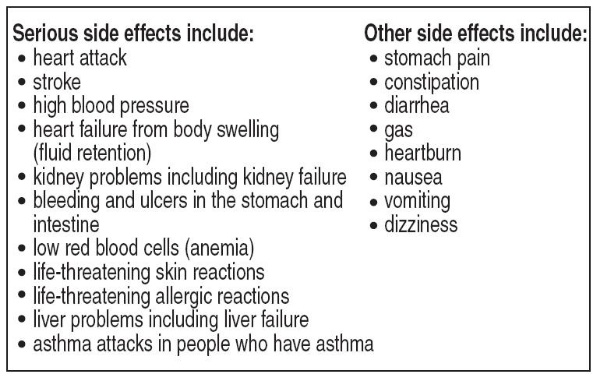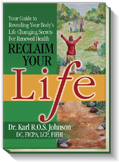
Tendonitis in any area of the body can be quite painful and debilitating, often interfering with your daily lifestyle.
I often see patients who have tendonitis and the challenge is to help the patient understand the various steps and procedures that need to be undertaken in the healing of this type of injury. Of course there are many different places in the body a tendon can be injured but the wrist, knee, and achilles tendons are the most common ones I have seen. In this blog post I outline a few aspects about tendon construction, tendon healing, and natural methods (drug-free, surgery-free) that I and others have found to be helpful and effective to enable patients to get back to their normal lifestyle.
Tendonitis refers to inflammation of a tendon, which is the tough rope-like tissue that attaches muscles to bones. Tendons vary in form, and can be rounded cords, strap- like bands or flattened ribbons. [1]
Overuse, injury, and various systemic inflammatory conditions of the body can cause tendonitis. Some medical researchers state that the term tendonitis should be reserved for use only after performing a biopsy and then examining the tissue under a microscope and instead, the term tendonopathy should be used until a biopsy is performed. Regardless of the term used, a good understanding of how to best approach a tendon injury is important.
Traditional medical treatment consists of immobilization (splints, wraps or casts), use of anti-inflammatory drugs, and physical therapies. With inflammtion of tendons, comes pain, and limited motion. Due to the limited motion and pain the body will naturally make the muscles attached to the tendons weaker to prevent more damage. Depending on the severity of the tendonitis, healing times and methods of treatment will vary. In severe cases surgery may be necessary.
Tendons heal slowly
Tendons are unique in how they are designed to endure long periods of tension with low use of energy; they have a low metabolism. Due to their unique design, tendons are known to heal very slowly after injury. [2]
Healing of tendons occurs in three overlapping stages:
- Initial inflammatory phase
- The remodeling stage
- The modeling stage (The modeling phase can be divided into a consolidation and maturation stage [3])
This whole three-step process can take about a year to complete! An important point to be aware of is that tendons once damaged, are not like the original tissue before injury. One researcher states it this way, "Despite remodeling, the biochemical and mechanical properties of healed tendon tissue never match those of intact tendon. Tendon injuries account for considerable morbidity, and often prove disabling for several months, despite what is considered appropriate management." [4]
The basic cell biology of tendons is still not fully understood, and the management of tendon injury poses a considerable challenge for clinicians.
One of the keys to successful tendon healing is to listen to your body and if you have increased pain with a certain movment or position, then you need to alter the way you use the injured area to give the tendon a fighting chance to heal.
One particular type of tendonapathy that involves the wrist is called De Quervain's Tenosynovitis (dih-kwer-VAINS ten-oh-sine-oh-VIE-tis). This is a painful condition affecting the tendons on the thumb side of your wrist. If you have De Quervain's Tenosynovitis, it will probably hurt when you turn your wrist, grasp anything or make a fist.
"Symptoms of De Quervain's Tenosynovitis include:
- Pain near the base of your thumb
- Swelling near the base of your thumb
- Difficulty moving your thumb and wrist when you're doing something that involves grasping or pinching
- A "sticking" or "stop-and-go" sensation in your thumb when moving it
If the condition goes too long without treatment, the pain may spread further into your thumb, back into your forearm or both. Pinching, grasping and other movements of your thumb and wrist aggravate the pain.
Chronic overuse of your wrist is commonly associated with De Quervain's tenure osynovitis.
Tendons are rope-like structures that attach muscle to bone. When you grip, grasp, clench, pinch or wring anything in your hand, two tendons in your wrist and lower thumb normally glide smoothly through the small tunnel that connects them to the base of the thumb. Repeating a particular motion day after day may irritate the sheath around the two tendons, causing thickening and swelling that restricts their movement.
Other causes of de Quervain's tenosynovitis include:
- Direct injury to your wrist or tendon; scar tissue can restrict move ment of the tendons
- Inflammatory arthritis, such as rheumatoid arthritis" [5]
Initial treatment of de Quervain's tenosynovitis may include:
- Immobilizing your thumb and wrist, keeping them straight with a splint or brace to help rest your tendons
- Avoiding repetitive thumb movements as much as possible
- Avoiding pinching with your thumb when moving your wrist from side to side
- Applying ice to the affected area" [5]
The patients who present to my office having had traditional treatments for tendonapathy and who are not responding to treatment require an alternative approach if they want to avoid surgery
Here are the seven keys for successful natural treatment for tendonitis:
- Avoid aggravating your painful tendon by altering your activity level to the point you don't increase pain to the injured area. If you need to wear a splint, use one that limits motion, but does not completely stop movement (unless you have a very severe tendonitis - almost to the point of tendon rupture). Total loss of motion impairs the healing process due to complex neurological mechanisms that are beyond the scope of this article.
- The use of healing lasers (often called cold laser or low level laser therapy) will speed up the process of healing, decrease inflammation and pain. [6, 7] One laser we use in our office is the Cutting Edge M6 laser with MLS technology.
- Pulsed electromagnetic field therapy (PEMF) is also known to speed up the healing process. [8,9] We use the Pulse Centers MagnaCharger Pro PEMF routinely in our tendon injury patients with great results.
- Treatment aimed "upstream" from the injury designed to improve the neurological integrity of the nerves that supply impulses is a key to enhanced recovery. [10] For example, if you have a shoulder, elbow or wrist tendonpathy I will be evaluating the integrity of your brachial plexus, which is a complex of nerves that eminate from the neck region. Typically specialized chiropractic ajustments are performed in the region of the spine where the upstream nerves emanate.
- Chronic pain and/or injury to a part of the body often leads to communication error between the brain and the muscles in and around the injured area (dysafferentation). Using Trigenics® Myoneural Therapy* can reset the abnormal communication between the injured tissue and the brain to restore muscle strength and muscle length. [11,12]
- Correction of abnormal loss or joint motion due to adhesions in the area of the tendonitis will speed up the process of tenonopathy healing. I have used extremity adjustments for years to help patients heal faster from tendon and ligament injuries. Reseach shows the efficacy of joint manipulation in ankle injuries. [13] Providing highly skilled extremity adjustments to patients is one of my fortes.
- Taking non-steroidal anti-inflammatory drugs (NSAIDs) for long periods of time is dangerous. Many studies show the adverse effects that can occur from long-term use as you can see in the table that follows:
 Instead, I recommend to patients to use research proven botanical agents and other natural products shown to modulate inflammation safely such as; white willow back, curcumin, omega-3 fatty acids, green tea, pycnogenol, boswelia, resveratrol, cat's claw & capsaicin. [14]
Instead, I recommend to patients to use research proven botanical agents and other natural products shown to modulate inflammation safely such as; white willow back, curcumin, omega-3 fatty acids, green tea, pycnogenol, boswelia, resveratrol, cat's claw & capsaicin. [14]In conclusion, if you are having trouble with healing a tendon injury, consider the multi-modal approach I have outlined above and you will discover a new world of healing, often unknown to the standard medical practitioner. Don't be surprised if you find someone in the traditional medical field advising you against being a patient of a doctor who doesn't use the "traditional" approach and who recommends a successful, natural treatment for tendonitis as outlined above. Unfortunately those medical practitioners either don't understand the science and physiology behind a more updated cause-centered approach or are just not aware (for whatever reasons) of natural/alternative/non-surgical treatments.
Don't keep this information a secret. Tell your friends and family that there are alternative approaches to tendonopathy. Refer them to this article today and use the social sharing options above.
Always remember one of my mantras., "The more you know about how your body works, the better you can take care of yourself."
For more details about the natural approach I take with my patients, take a look at the book I wrote entitled: Reclaim Your Life; Your Guide To Revealing Your Body's Life-Changing Secrets For Renewed Health. It is available in my office or at Amazon and many other book outlets. If you found value in this article, please use the social sharing icons at the top of this post and please share with those you know who are still suffering with chronic health challenges, despite receiving medical management. Help me reach more people so they may regain their zest for living! Thank you!
ALL THE BEST – DR. KARL R.O.S. JOHNSON, DC – DIGGING DEEPER TO FIND SOLUTIONS
Sources:
- Benjamin M, Ralphs J. Functional and developmental anatomy of tendons and ligaments. In: Gordon SL, Blair SJ, Fine LJ (eds) Repetitive Motion Disorders of the Upper Extremity. American Academy of Orthopaedic Surgeons, Rosemont, USA; 1995:185-203
- Williams JG. Achilles tendon lesions in sport. Sports Med 1986; 3:114-135.
- Tillman LJ, Chasan NP. Properties of dense connective tissue and wound healing. In: Hertling D, Kessler RM (eds) Management of Common Musculoskeletal Disor- ders. Lippincott, Philadelphia, USA; 1996:8-21.
- Almekinders LC, Almekinders SV. Outcome in the treatment of chronic overuse sports injuries: a retro- spective study. J Orthop Sports Phys Ther 1994; 19:157- 161.
- http://www.mayoclinic.org/diseases-conditions/de-quervains-tenosynovitis/basics/definition/con-20027238
- http://www.ncbi.nlm.nih.gov/pubmed/23179310
- https://chiro-trust.org/whole-body-health/tissue-healing-low-level-laser-therapy/
- http://www.doctoroz.com/article/pulsed-electromagnetic-fields-how-they-heal
- http://www.archives-pmr.org/article/S0003-9993(97)90232-X/abstract?cc=y=
- http://www.ncbi.nlm.nih.gov/pmc/articles/PMC2408985/pdf/joa0212-0211.pdf
- http://www.canadianchiropractor.ca/techniques/an-interactive-neurological-treatment-system-901
- http://www.canadianchiropractor.ca/techniques/addressing-the-functional-trauma-cycle-870
- http://www.ncbi.nlm.nih.gov/pmc/articles/PMC3103112/pdf/jmt-18-01-022.pdf
- http://www.ncbi.nlm.nih.gov/pmc/articles/PMC3011108/?report=printable



